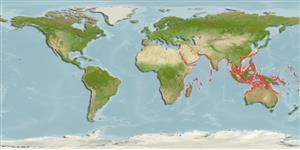Environment: milieu / climate zone / depth range / distribution range
Ecology
Marine; brackish; demersal; amphidromous (Ref. 51243); depth range 45 - 90 m (Ref. 68964). Tropical
Indo-West Pacific: southern Arabian Sea and Bay of Bengal through Malaysia, Indonesia to Bali and Celebes, Gulf of Thailand, Viet Nam, Hong Kong and southern Philippines. Also reported from the Arafura Sea (Ref. 9819). Records from the northern Arabian Sea, Persian Gulf and east coast of Africa probably refer to other species.
Size / Weight / Age
Maturity: Lm ? range ? - ? cm
Max length : 30.0 cm TL male/unsexed; (Ref. 9790); common length : 20.0 cm TL male/unsexed; (Ref. 9790)
Dorsal spines (total): 9; Dorsal soft rays (total): 11 - 13. Lateral line scales often 53, each scale with a backward directed spine that extends beyond rear margin of scale, especially along the caudal peduncle. Interorbital width 9% or more of head length.
Taken by trawling over mud and sand at depths to about 55 m (Ref. 9790). Juveniles may enter brackish water.
Life cycle and mating behavior
Maturity | Reproduction | Spawning | Eggs | Fecundity | Larvae
Kuronuma, K. and Y. Abe, 1986. Fishes of the Arabian Gulf. Kuwait Institute for Scientific Research, State of Kuwait, 356 p. (Ref. 5999)
IUCN Red List Status (Ref. 130435: Version 2024-2)
Threat to humans
Harmless
Human uses
Fisheries: minor commercial
Tools
Special reports
Download XML
Internet sources
Estimates based on models
Preferred temperature (Ref.
123201): 23.3 - 28.3, mean 27.2 °C (based on 347 cells).
Phylogenetic diversity index (Ref.
82804): PD
50 = 0.6250 [Uniqueness, from 0.5 = low to 2.0 = high].
Bayesian length-weight: a=0.00550 (0.00314 - 0.00962), b=3.07 (2.91 - 3.23), in cm total length, based on LWR estimates for this species & (Sub)family-body (Ref.
93245).
Trophic level (Ref.
69278): 3.8 ±0.6 se; based on size and trophs of closest relatives
Resilience (Ref.
120179): Medium, minimum population doubling time 1.4 - 4.4 years (Preliminary K or Fecundity.).
Fishing Vulnerability (Ref.
59153): Low vulnerability (20 of 100).
